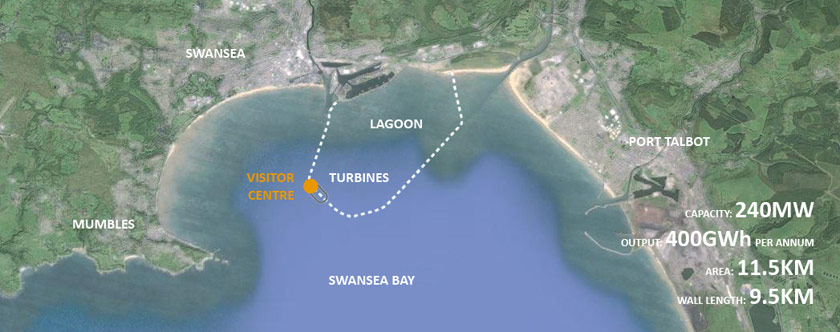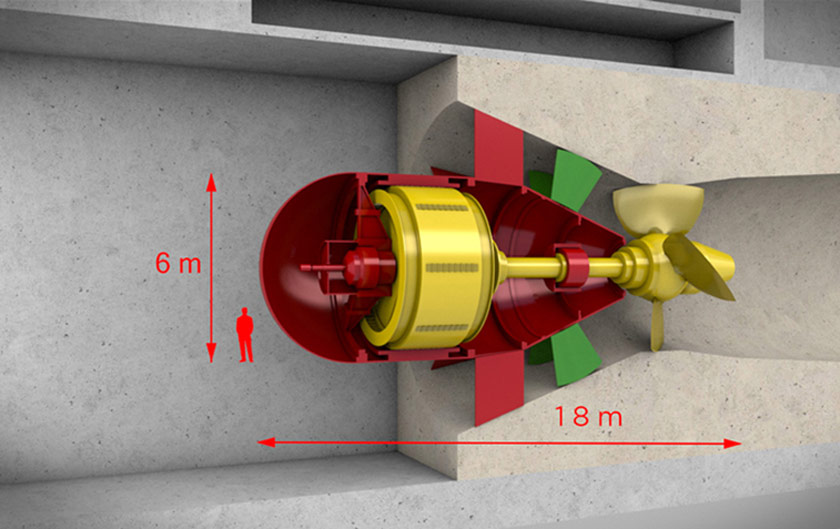Tidal Lagoon - Swansea Bay
The Vision
The Tidal Lagoon Swansea Bay will be the world’s first, man-made, energy-generating lagoon, harnessing reliable, low-cost, abundant renewable energy set within Swansea Bay which benefits from an average tidal range during spring tides of 8.5m.
The Lagoon will provide clean and predictable power for over 120,000 homes (enough to power 70% of Swansea Bay's annual domestic electricity use) for 120 years and make an important contribution towards national carbon emission reduction targets – over 216,000 tonnes of CO2 saved each year.
The Lagoon provides a further opportunity to develop a tidal range industry for the UK, centred around the Wales Community and tourism opportunities covering education, arts, culture, recreation and sports.

Why?
The UK faces an unprecedented challenge in its ability to deliver secure, affordable electricity in the coming decades. The security of supply is threatened as around 20GW of electricity generation is lost by the closure of older and polluting plants.
If this capacity is not replaced, blackouts may be a real possibility in Britain in the next 10 years (DECC 2011) and parallel to this is the need to decarbonise electricity generation.
As a result of EU targets, the UK has committed to producing 15% of its electricity from renewable resources by 2020. In UK law, a reduction in the production of greenhouse gases by 80% below 1990 levels by 2050 is a key provision of the Climate Change Act 2008.
All this takes place against a backdrop of increasing demand for electricity over the next 50 years.
An increase in the proportion of energy generation from renewable sources is an essential means by which these ambitions may be achieved. The UK currently achieves just 4.1% of energy generation from renewable sources (DECC, 2013).
In parallel the Welsh Obligations set out that Wales is seeking to achieve a renewable electricity production target of 7TWh per annum by 2020. The Energy Policy Statement, 2010 details how Wales has the potential to produce twice the amount of electricity it currently uses from renewable sources by 2025, with 40% coming from marine sources
Why Tidal Energy?
The UK Government believes that tidal power could play a significant role in the future generation of electricity for the UK. The UK Marine Policy Statement (March 2011) notes that tidal range schemes could provide up to 15% of the UK’s current electricity demand and that tidal power has the potential to provide a significant contribution to the share of energy supply from renewable resources in Wales and the UK.
Tidal energy generated from a tidal range barrage provides a predictable, reliable base load of renewable energy for up to 14 hours a day, which can be used to balance the energy produced by more intermittent renewable technologies and reduce the need for greenhouse gas producing fossil fuel generating stations to provide this resource. In this way, the Project offers the opportunity to exploit renewable energy to meet the energy challenge Britain faces over the coming decade.
Furthermore EU Member states are committed to the ‘further development and promotion of renewable energy technologies’
What is a Tidal Lagoon?
Tidal lagoons are a simple concept involving the adaptation of standard, proven components used in global engineering projects. The Swansea Bay lagoon will comprise a UK standard sand-core breakwater or rock bund, similar to many seen in coastal defence schemes and harbour walls.
The tidal lagoon has been designed to dramatically reduce the cost, materials and carbon involved in traditional construction of a breakwater or sea wall, thus increasing the viability of the project. Significant cost savings and reduced construction times can be achieved by the replacement of a rock mound with locally sourced dredged materials and casings, which have been used in many global marine schemes.
Construction techniques are proposed that use dredged sandy materials from a relatively thin layer the sea bed within the lagoon, which are then hydraulically filled into long geotextile casings known as Geotubes® On top of these Geotubes® and compact sand fill are placed small rocks and on top of this the larger rock armour to protect against degradation.
The generating equipment of bulb hydro turbines have been used for many years on run-of-river hydro power schemes as well as some landmark tidal barrages. The hydro turbines are mounted inside concrete turbine housings and are permanently submerged so the resulting view is of a ring-shaped harbour wall with one section of concrete casing. The proposed turbines will have a runner diameter (span of the turbine blades) in the region of 7m and will be permanently submerged below the low water level in Swansea Bay.
The turbines generate electricity as sea water flows through them due to the tidal action. This process can work in both directions therefore generating electricity 4 times a day.

Project benefits
Other benefits than the obvious environment advantages of generating electricity from a reliable renewable resource include the supply chain through local manufacturing of component parts estimated at approximately £300m with the possibility of creating approximately 2880 construction jobs.
The Visitor Centre could attract between 70 – 100,000 visitors a year creating further 40 jobs within the tourist sector and the lagoon will become a major and recreational facility showcasing tidal range technology and providing There is significant potential for the tidal lagoon to become a foundation venue for local and national sports use. Cycling, walking and running around the lagoon wall, as well as open water swimming, rowing and sailing are further examples of alter uses.
The tidal lagoon could form a cornerstone development for Swansea Bay City Region as regards marine energy, as well as helping to facilitate local regeneration objectives in South Wales and stimulating a vibrant waterfront economy.